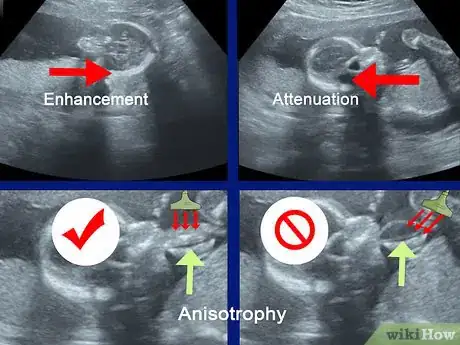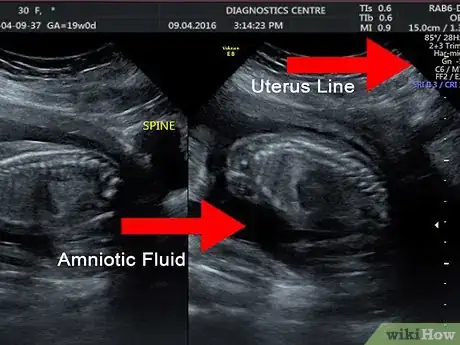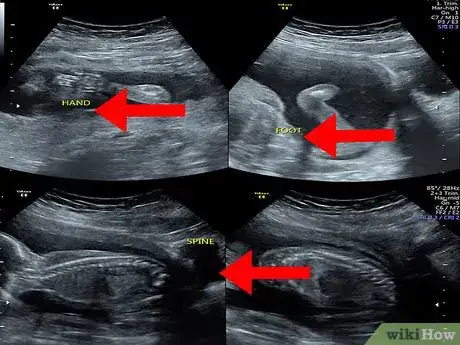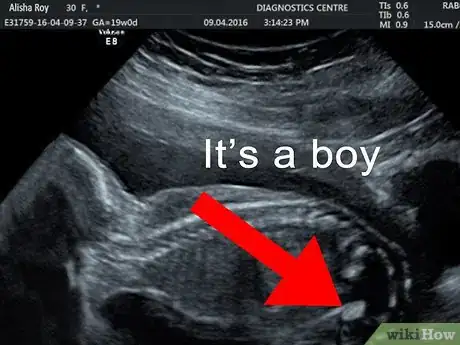This article was medically reviewed by Sarah Gehrke, RN, MS. Sarah Gehrke is a Registered Nurse and Licensed Massage Therapist in Texas. Sarah has over 10 years of experience teaching and practicing phlebotomy and intravenous (IV) therapy using physical, psychological, and emotional support. She received her Massage Therapist License from the Amarillo Massage Therapy Institute in 2008 and a M.S. in Nursing from the University of Phoenix in 2013.
There are 10 references cited in this article, which can be found at the bottom of the page.
This article has been viewed 1,599,293 times.
An ultrasound may be performed for a variety of reasons, but looking at a baby in the womb is the most common reason. If you have recently had an ultrasound and you want to know how to interpret the images on your ultrasound, then you may benefit from learning about some of the basics of ultrasound imaging. You may also want to know how to pick out specific features of your pregnancy ultrasound, such as the baby’s head, arms, or sex. Just keep in mind that ultrasounds can be difficult to interpret, so it is best to do so with the help of your doctor.
Steps
Deciphering the Images
-
1Disregard the text and numbers at the top of your scan. Most hospitals and ultrasound centers use this space to include details like your name, hospital reference number, or ultrasound machine settings. Since this information does not have anything to do with what you see on the ultrasound image, you can ignore this information.[1]
-
2Start from the top of the image. The top of the screen or printed image is where the ultrasound probe was placed. In other words, the image you see shows what the organ or tissues look like from the side rather than from the top.[2]
- For example, if you are having an ultrasound of your uterus, then what you see at the top of the screen or printed ultrasound would be the outline of the tissues above your uterus. As you look further down the screen, you will see deeper tissues, such as the lining of your uterus, the inside of your uterus, and the back of your uterus.
Advertisement -
3Consider the differences in colors. Most ultrasound images are in black and white, but you can see differences in the shades of black and white in your ultrasound scan. The color differences come from the differences in the densities of the materials that the sound passes through.
- Solid tissues, like bone, will appear white because the outer surface reflects more sound.
- Tissues that are filled with liquid, such as the amniotic fluid in the uterus, will appear dark.[3]
- Ultrasound imaging does not work well for gas, so organs that are filled with air, like the lungs, are generally not examined with ultrasound.
-
4Determine the visible side of the body. Most ultrasound images are mirrored, meaning you see the left side of the body on the left side of the image. If you have a transvaginal ultrasound, though, it uses a straight shot. A straight shot will show the left side of the body on the right side of the image.[4]
- If you are unsure about what type of ultrasound is being performed, ask your ultrasound technician.
-
5Watch for common visual effects. Since ultrasound uses sound to create images of the inner structures of your body, the images are not crystal clear. There are many different visual effects that can happen as a result of the ultrasound’s settings, angle, or of the density of the tissues being examined. Some of the most common visual effects to watch for include:[5]
- Enhancement. This is when part of the structure being examined appears brighter than it should due to an excess of fluids in the area, such as in a cyst.
- Attenuation. Also known as shadowing, this effect causes the area being scanned to appear darker than it should.
- Anisotropy. This effect has to do with the angle of the probe. For example, holding the probe at a right angle to some tendons would cause the area to appear brighter than normal, so it is necessary to adjust the angle of the probe to avoid this effect.
Reading a Pregnancy Ultrasound
-
1Identify your womb. You can identify the outline of your uterus by finding the white or light grey line around the edges of the ultrasound image. Just inside of this area, there should be a black area. This is the amniotic fluid.[6] [7]
- Keep in mind that the edge of the womb may not go around the entire image. The technician may have positioned the probe in a way that centered the image on your baby. Even if you only see white or grey lines along one or two sides of the image, this is probably the outline of your womb.
-
2Spot the baby. Your baby will also look grey or whitish and will be located within the amniotic fluid (the dark area inside of the womb). Look at the area within your amniotic fluid to try to make out the outline and features of your baby.
- The details that you see in the image will depend on the stage of your pregnancy. For example, at eight weeks, the fetus will look something like a gummy bear or a baked bean; at 12 weeks, you may only be able to identify the head of your baby; while at 20 weeks, you may be able to see the spine, eyes, feet, and heart.[8]
-
3Determine your baby’s sex. At around 18 to 20 weeks, you will have an ultrasound to check your baby’s development, identify any problems, and possibly even identify the sex]] of your baby. It’s important to remember that it is not always possible to determine the sex of your baby at this stage and you won’t know for sure until your baby is born.[9]
- To determine the sex of your baby, the ultrasound technician or obstetrician will look for a penis or three lines that represent the labia. Keep in mind that this method of determining the sex of your baby is not 100% accurate. A visual effect may create or obscure the image of a penis on an ultrasound.
-
4Consider a 3D or 4D ultrasound. If you are interested in seeing more details of your baby than a traditional ultrasound can provide, then you may want to ask your doctor about a 3D ultrasound. A 3D ultrasound can show your baby’s facial features and it may even be able to detect certain defects, such as a cleft lip and palate.[10] A 4D ultrasound uses the same imaging as a 3D scan, but a 4D scan makes a short video recording of your baby in the womb.[11]
- If you want to have a 3D or 4D ultrasound, the best time to do so is between 26 to 30 weeks.
- Keep in mind that these scans can be quite expensive and may not be covered by your insurance unless there is a medical reason to have one done, such as to investigate an abnormality.
Expert Q&A
-
QuestionHow will I know the exact weeks of my pregnancy?
 Lacy Windham, MDLacy Windham, MD, is a Board-Certified Obstetrician & Gynecologist in Cleveland, Tennessee. Dr. Windham attended medical school at the University of Tennessee Health Science Center in Memphis. Her residency was completed at Eastern Virginia Medical School in Norfolk, Virginia. She was the recipient of multiple awards during her residency training, including Most Outstanding Resident in Maternal Fetal Medicine, Most Outstanding Resident in Oncology, Most Outstanding Resident Overall, and Special Award in Minimally Invasive Surgery.
Lacy Windham, MDLacy Windham, MD, is a Board-Certified Obstetrician & Gynecologist in Cleveland, Tennessee. Dr. Windham attended medical school at the University of Tennessee Health Science Center in Memphis. Her residency was completed at Eastern Virginia Medical School in Norfolk, Virginia. She was the recipient of multiple awards during her residency training, including Most Outstanding Resident in Maternal Fetal Medicine, Most Outstanding Resident in Oncology, Most Outstanding Resident Overall, and Special Award in Minimally Invasive Surgery.
Board Certified Obstetrician & Gynecologist Measurements will be taken at the time of ultrasound, depending on the gestational age. Early gestations are measured by the crown-rump length, and later gestations are measured by an algorithm using head, abdomen and femur measurements. Determining an accurate gestational age is also dependent on how far along the pregnancy is. If you are dated by measurements that show you to be 6 weeks pregnant, this is extremely accurate. If you are measuring when you are close to your due date, this is extremely inaccurate.
Measurements will be taken at the time of ultrasound, depending on the gestational age. Early gestations are measured by the crown-rump length, and later gestations are measured by an algorithm using head, abdomen and femur measurements. Determining an accurate gestational age is also dependent on how far along the pregnancy is. If you are dated by measurements that show you to be 6 weeks pregnant, this is extremely accurate. If you are measuring when you are close to your due date, this is extremely inaccurate. -
QuestionWhat does fetus A/1 mean on USG?
 Lacy Windham, MDLacy Windham, MD, is a Board-Certified Obstetrician & Gynecologist in Cleveland, Tennessee. Dr. Windham attended medical school at the University of Tennessee Health Science Center in Memphis. Her residency was completed at Eastern Virginia Medical School in Norfolk, Virginia. She was the recipient of multiple awards during her residency training, including Most Outstanding Resident in Maternal Fetal Medicine, Most Outstanding Resident in Oncology, Most Outstanding Resident Overall, and Special Award in Minimally Invasive Surgery.
Lacy Windham, MDLacy Windham, MD, is a Board-Certified Obstetrician & Gynecologist in Cleveland, Tennessee. Dr. Windham attended medical school at the University of Tennessee Health Science Center in Memphis. Her residency was completed at Eastern Virginia Medical School in Norfolk, Virginia. She was the recipient of multiple awards during her residency training, including Most Outstanding Resident in Maternal Fetal Medicine, Most Outstanding Resident in Oncology, Most Outstanding Resident Overall, and Special Award in Minimally Invasive Surgery.
Board Certified Obstetrician & Gynecologist If you are having a single pregnancy, it just refers to the baby. If you are having twins or triplets, it is a way to keep track of which baby is being measured.
If you are having a single pregnancy, it just refers to the baby. If you are having twins or triplets, it is a way to keep track of which baby is being measured. -
QuestionHow do I determine if a baby will be a boy or a girl based on a five-month scan?
 Sarah Gehrke, RN, MSSarah Gehrke is a Registered Nurse and Licensed Massage Therapist in Texas. Sarah has over 10 years of experience teaching and practicing phlebotomy and intravenous (IV) therapy using physical, psychological, and emotional support. She received her Massage Therapist License from the Amarillo Massage Therapy Institute in 2008 and a M.S. in Nursing from the University of Phoenix in 2013.
Sarah Gehrke, RN, MSSarah Gehrke is a Registered Nurse and Licensed Massage Therapist in Texas. Sarah has over 10 years of experience teaching and practicing phlebotomy and intravenous (IV) therapy using physical, psychological, and emotional support. She received her Massage Therapist License from the Amarillo Massage Therapy Institute in 2008 and a M.S. in Nursing from the University of Phoenix in 2013.
Registered Nurse The 20-week scan (5-month scan) is the best way to determine fetal development and growth. At this time, your healthcare provider can see the images of your baby to help determine if you are having a boy (penis is present) or a girl (no penis).
The 20-week scan (5-month scan) is the best way to determine fetal development and growth. At this time, your healthcare provider can see the images of your baby to help determine if you are having a boy (penis is present) or a girl (no penis).
References
- ↑ http://www.motherandbaby.co.uk/pregnancy-and-birth/pregnancy/pregnancy-scans-tests-and-advice/your-pregnancy-ultrasound-scan-photo-explained
- ↑ https://accessanesthesiology.mhmedical.com/content.aspx?bookid=517§ionid=41066789
- ↑ https://www.motherandbaby.co.uk/pregnancy-and-birth/pregnancy/pregnancy-scans-tests-and-advice/your-pregnancy-ultrasound-scan-photo-explained
- ↑ http://www.meddean.luc.edu/lumen/meded/urology/ushome.htm
- ↑ https://radiopaedia.org/articles/attenuation
- ↑ http://www.motherandbaby.co.uk/pregnancy-and-birth/pregnancy/pregnancy-scans-tests-and-advice/your-pregnancy-ultrasound-scan-photo-explained
- ↑ http://www.radiologyinfo.org/en/info.cfm?pg=genus
- ↑ http://www.motherandbaby.co.uk/pregnancy-and-birth/pregnancy/pregnancy-scans-tests-and-advice/your-pregnancy-ultrasound-scan-photo-explained
- ↑ http://americanpregnancy.org/prenatal-testing/ultrasound/
About This Article
To read an ultrasound picture, look for white spots on the image to see solid tissues, like bones, and dark spots on the image to see fluid-filled tissues, like the amniotic fluid in the uterus. If you're 12 weeks along in the pregnancy, you may be able to make out your baby's head, and if you're 20 weeks along, you may even see the spine, heart, feet, and eyes. Don't worry about the numbers and letters at the top of the ultrasound since they're just a reference for the hospital and not related to the picture itself. To learn how to determine the sex of your baby by looking at an ultrasound, scroll down!








































































Medical Disclaimer
The content of this article is not intended to be a substitute for professional medical advice, examination, diagnosis, or treatment. You should always contact your doctor or other qualified healthcare professional before starting, changing, or stopping any kind of health treatment.
Read More...